This post may contain affiliate links. We may receive a small commission, at no cost to you, if you make a purchase. Read Disclosure.
Ah, Florence, the cradle of the Renaissance and a city steeped in history as rich as its gelato flavors!
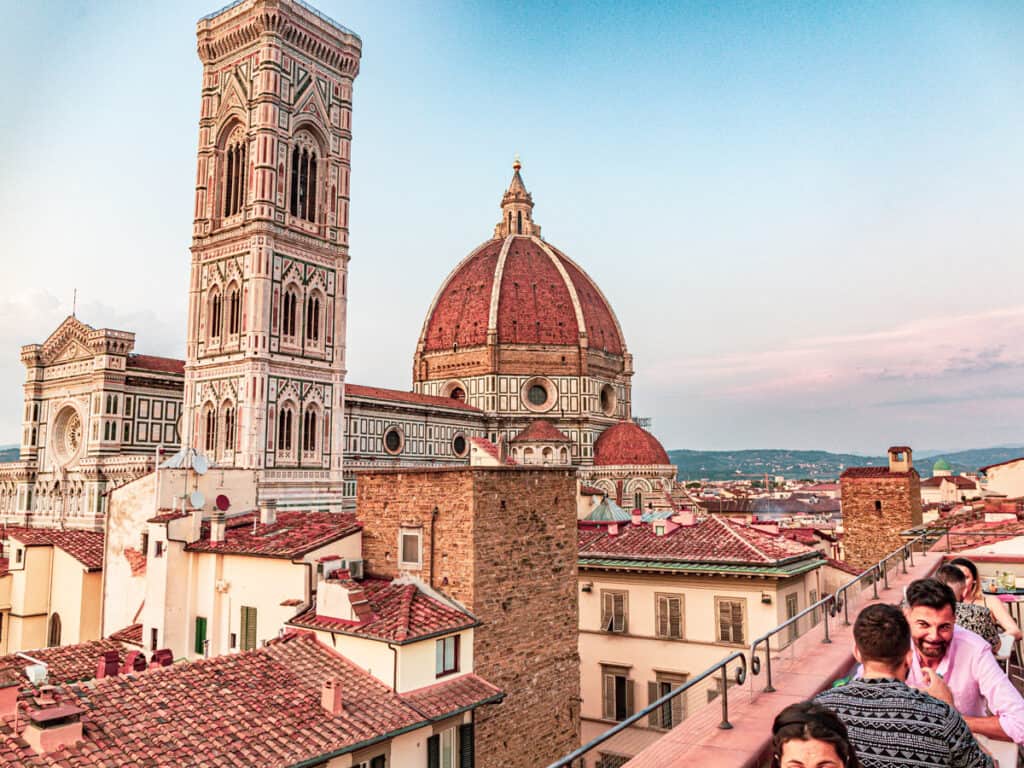
There is no better way to fully understand its fascinating story of the ages, than a walking tour of Florence with an expert local guide. Otherwise, that’s a lot to learn and discover on your own as you struggle through crowds at popular museums and city streets.
If you’re anything like me, overwhelmed and exhausted, and you throw your hands up in resignation to walk down to the river for quiet time, saying “Just give me gelato. Who cares about the Medici family anyway?”
There is no real reason to care about them, crowds or not, but it does speak a fascinating tale of ancient mobster-style power ruling.
The story is best told to you from an expert on a Florence Walking Tour, who can sum it up and share the most important bits from medieval times, the Renaissance, and how this has impacted the modern day city.
In this guide, we’ll share what to expect from a walking tour in Florence based on our personal experience.
Best of Florence Walking Tour with David & The Duomo
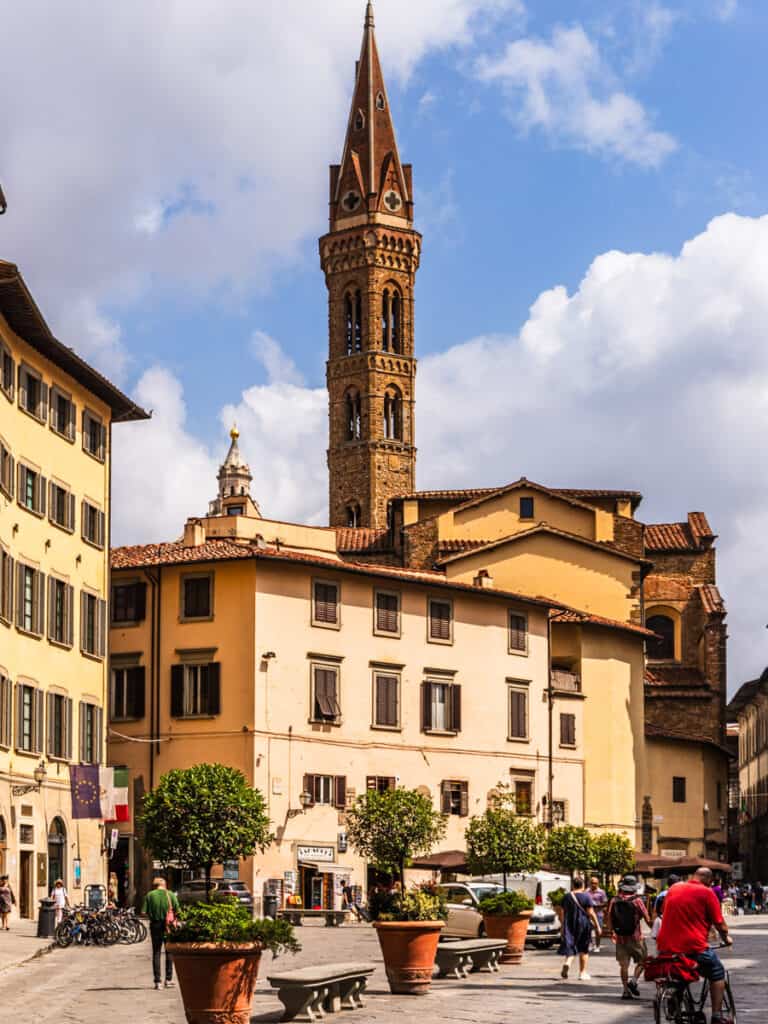
We joined a three-hour Best of Florence walking tour as guests of Walks of Italy. Our local guide, Neb, knows this city, and its art very well, as he studied on a scholarship at the Accademia di Belle Arti di Firenze (Academy of Fine Arts of Florence), which was founded by Cosimo I de’ Medici in 1563.
Although Neb says he’s more of a modern abstract artist, which is not celebrated so much in a city still wallowing in the glory of master artists like Leonardo da Vinci, Michelangelo, Donatello, and Botticelli (I loved his work at the Uffizi Gallery)
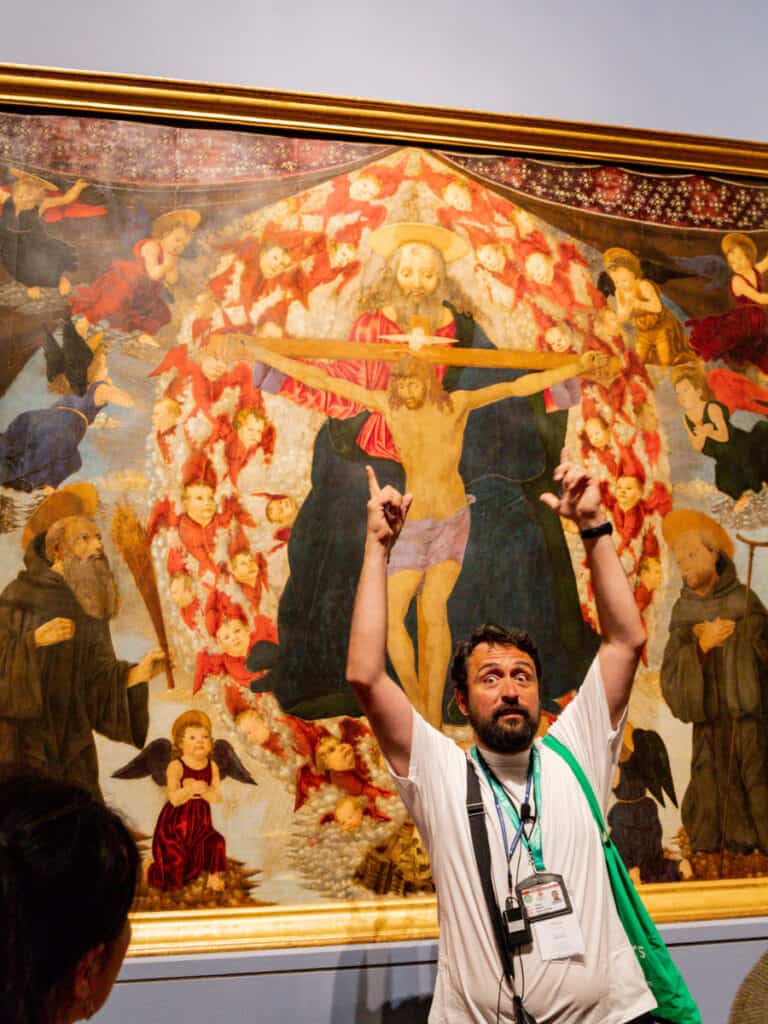
Neb gave us so much information as we wandered the streets of this well-preserved Medieval City. We had visited Siena in Tuscany just a few days before, which is a similarly beautiful Medieval city and Florence’s biggest rivals during these times.
This three-hour tour has a fair amount of walking and a lot of information. It was the most in-depth of all the walking tours we did in Italy.
Florence’s story can’t be told in a simple paragraph! So be prepared. You may find it a little overwhelming, especially with kids.
Ours loved seeing the Statue of David and some other aspects, but it was probably a little too long for them. I love soaking up the stories of the past, so I found it great, albeit tiring.
Medici’s, Middle Ages & Renaissance: A Brief History
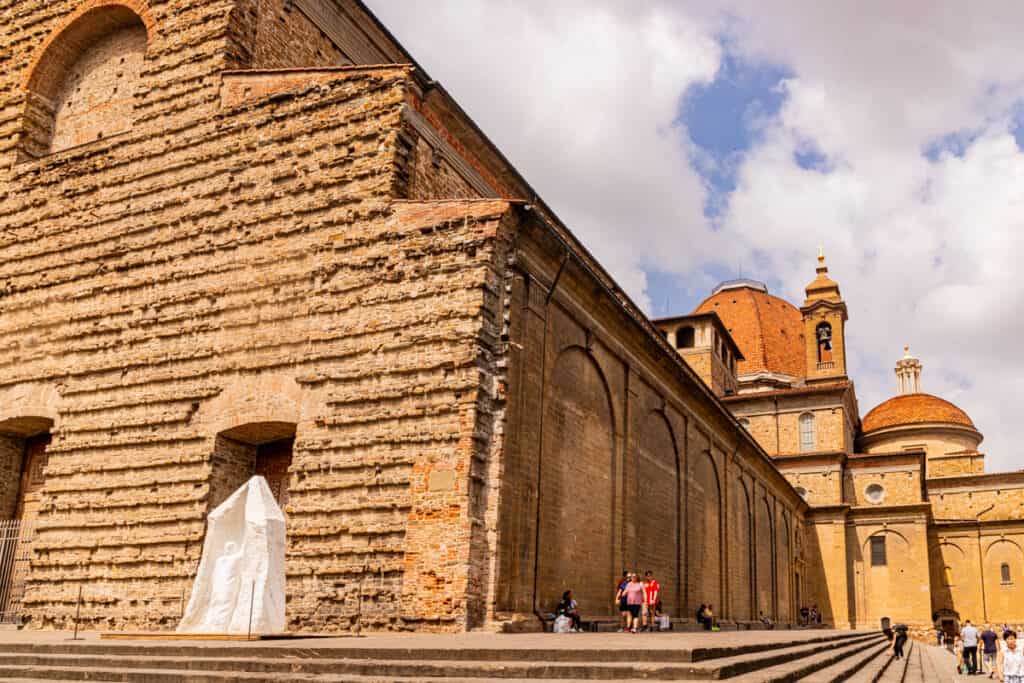
Our guided tour took us on the journey through this Medieval and Renaissance period as we walked through the city of Florence.
The Middle Ages is when this previous Roman settlement known as Florentia started flexing its cultural muscles. It became a hub for trade, textile production, and the arts. But it wasn’t until the 14th and 15th centuries that Florence truly found its groove as the epicenter of the Renaissance.
The Renaissance was a rebirth of culture, learning, and artistic expression. It was a departure from the religious-focused art of the Middle Ages, embracing a human-centered approach that celebrated individualism, curiosity, and the exploration of the natural world.
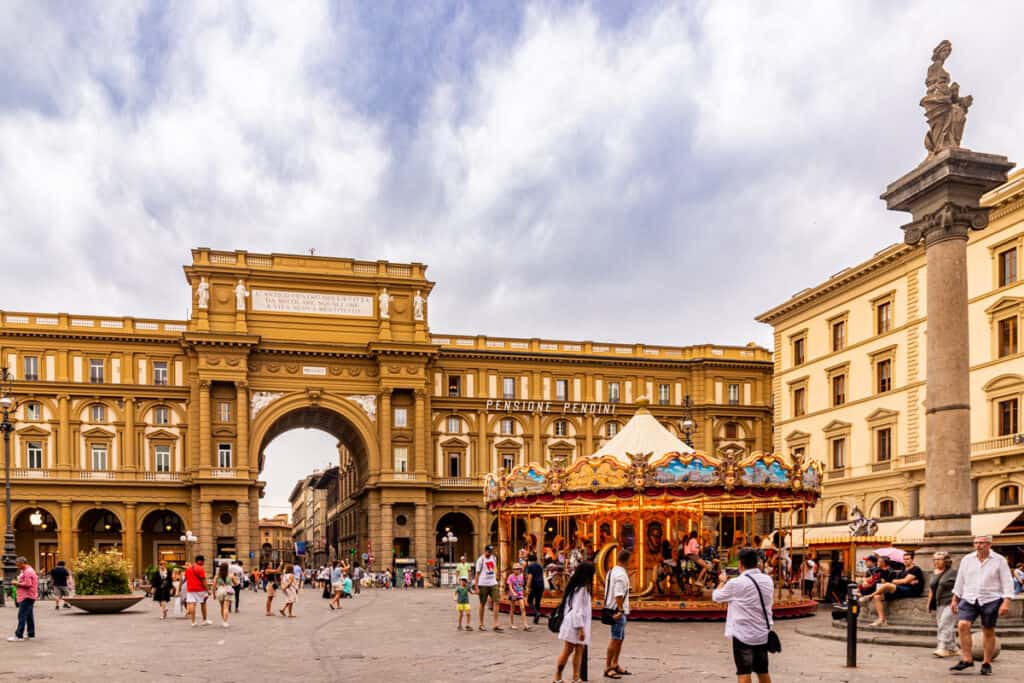
During this time, artists were no longer seen as mere craftsmen, but as thinkers and creators. They sought to capture the beauty of the world through realistic representation, and their works often reflected a profound understanding of human anatomy, perspective, and light.
Leonardo da Vinci, Michelangelo, Botticelli, and Galileo Galilei were strutting their stuff on the cobblestone streets of Florence, producing masterpieces that would go on to define Western art and science.
Spicing up the stories of the artistic and cultural revolution were those of the ambition, betrayal, power struggles and political game plays by the church and the Medici Family – powerful bankers that ruled the city with a financial iron fist, but also helped Florence to blossom into this hotspot for artists, philosophers, and thinkers.
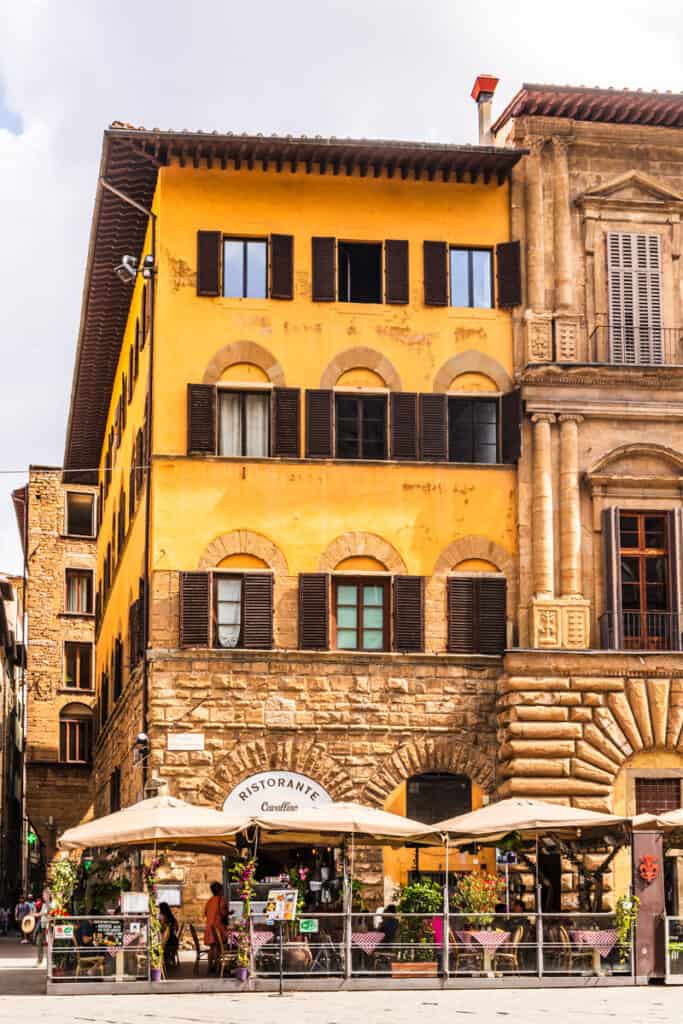
You gotta take the good with the bad I guess as all of this has contributed to Florence becoming a magnet for art lovers, history buffs, and wanderers seeking the enchantment of the past.
Its cobblestone streets, magnificent palaces, and world-class museums continue to draw visitors from around the globe, all eager to experience the magic that has made Florence an eternal masterpiece.
Let’s get walking and see some of the stops made on the Florence walking tour.
Highlights of the Florence Walking Tour
Now you’ve been fully brushed up on the history of the Medici family and the key events in Florence, it’s time to take a look at the stops on the Florence Walking Tour featuring David & The Duomo.
Stop 1: Florence Accademia
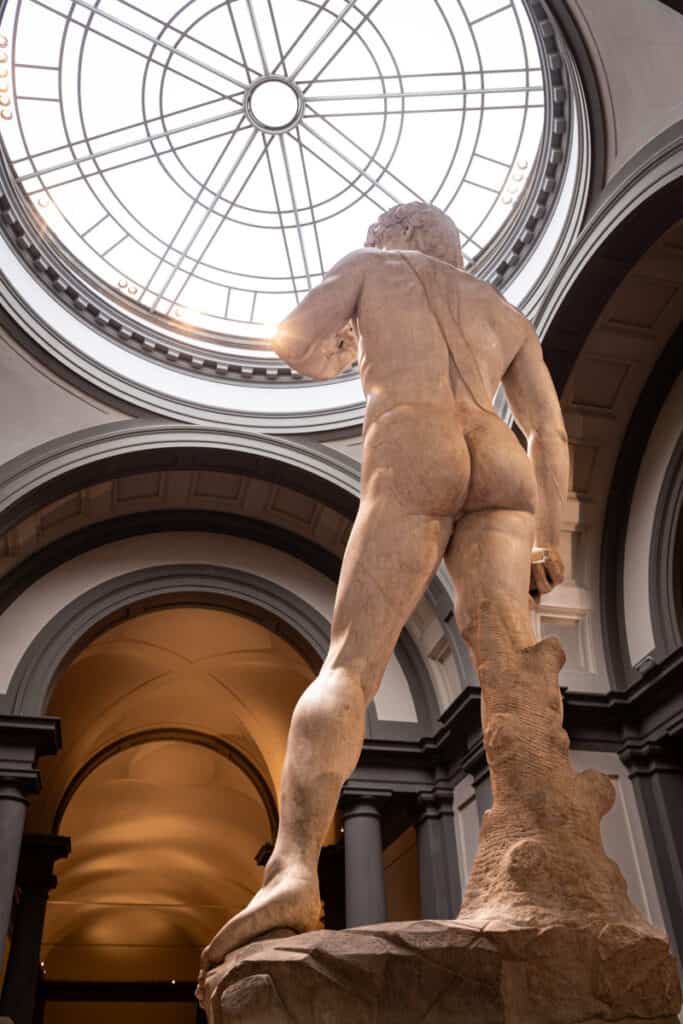
First stop? The Florence Accademia – and guess what? You’re skipping those pesky lines and diving right into Michelangelo’s David.
I saw this statue in 1998 as a 22-year-old and can barely remember it (obviously the brain was formed properly back then!)
But this time. Wow! I quickly forgot all the other pieces of art and artists Nebu pointed out to us moments before in the other rooms of the Accademia. Did they even matter?
We turned the corner and literally stopped in our tracks as the overwhelming magnetic presence of a 17ft high David took up all the space. Now, I can see why this is still to this day – years later – known to be the best sculpture in the world.
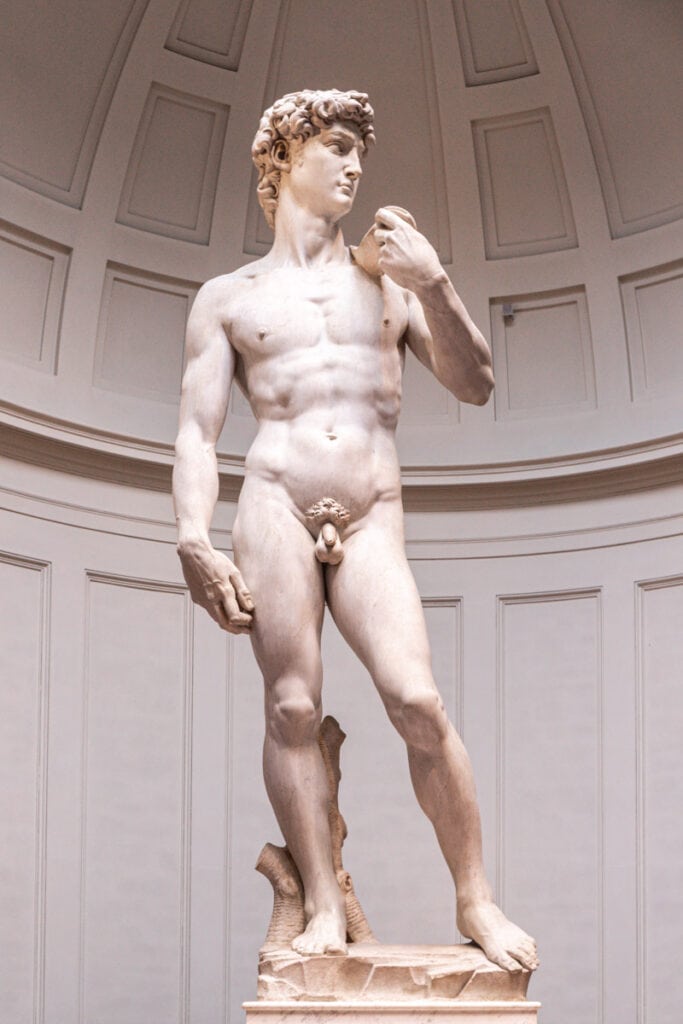
We stayed in here for some time gazing at David as Neb told us the story of Michaelangelo’s life from when he first started to carve at the age of 13, to his masterpieces that included David, Peita that we saw in St Peter’s Basilica in the Vatican, and of course the famous Sistine Chapel, and until his death at the age of 89.
It is said he carved David without using a plaster model as other sculptures did. For Michelangelo, it was simply a matter of “when I see the block of marble, I see the figure and just liberate it.”
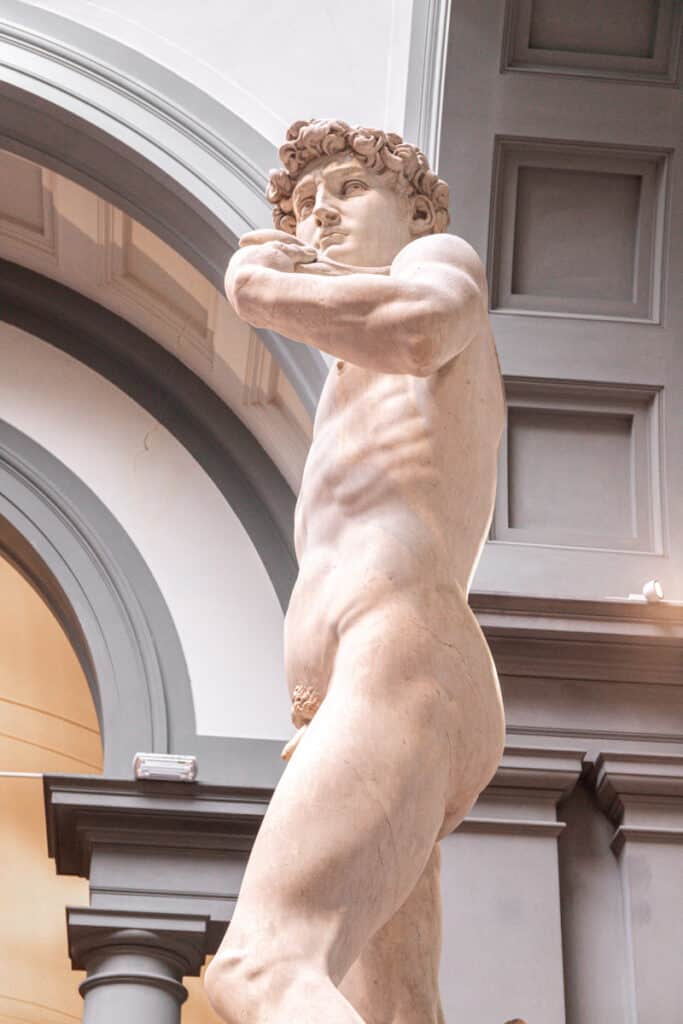
David was placed in front of City Hall at Piazza della Signoria, the first big size nude sculpture placed in a public space. In 1873 it was moved into the Accademia. A copy now sits in its place at the City Hall, but it doesn’t have the true Michaelangelo energy that the one on the Accademia does.
I enjoyed seeing the powerful beauty in the way this muscular body had been sculptured to perfection.

The Statue of David is an unmissable site in Florence. I was grateful we could bypass those long lines and easily navigate crowded spaces thanks to our guided tour.
There are many other famous works of art to see inside the Accademia Gallery, so if this is your thing, I suggest revisiting at another time with a skip the line pass. We were all happy with a quick overview visit.
Stop 2: The Florence Duomo
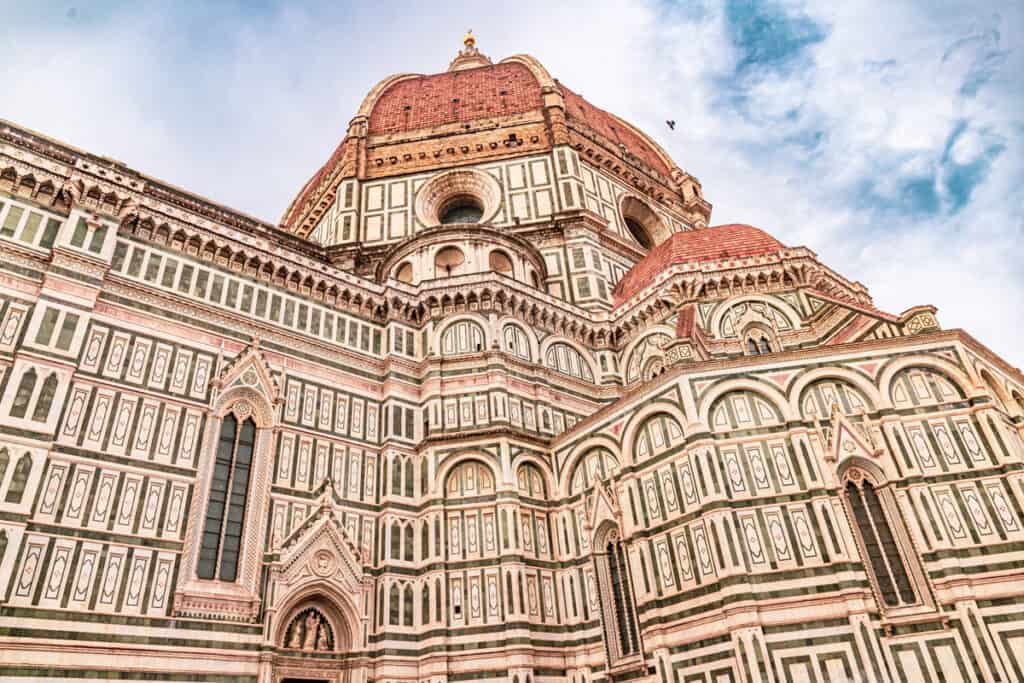
As we wandered towards the Florence Duomo (Florence Cathedral) Neb told us more about Tuscan life including the importance of wine and how it’s made.
We learned a lot about it – and sampled many – the previous day on our Florence food and wine tour of the Oltrarno neighborhood.
But it was not wine sampling time now, it was time to look at what was once the biggest church in the world, accommodating up to 30,000 worshippers.
The Florence Duomo, also called Florence Cathedral or Cathedral of Santa Maria Novella del Fiore and has been reigning over the city since 1436, flaunting one of the biggest domes on the planet.
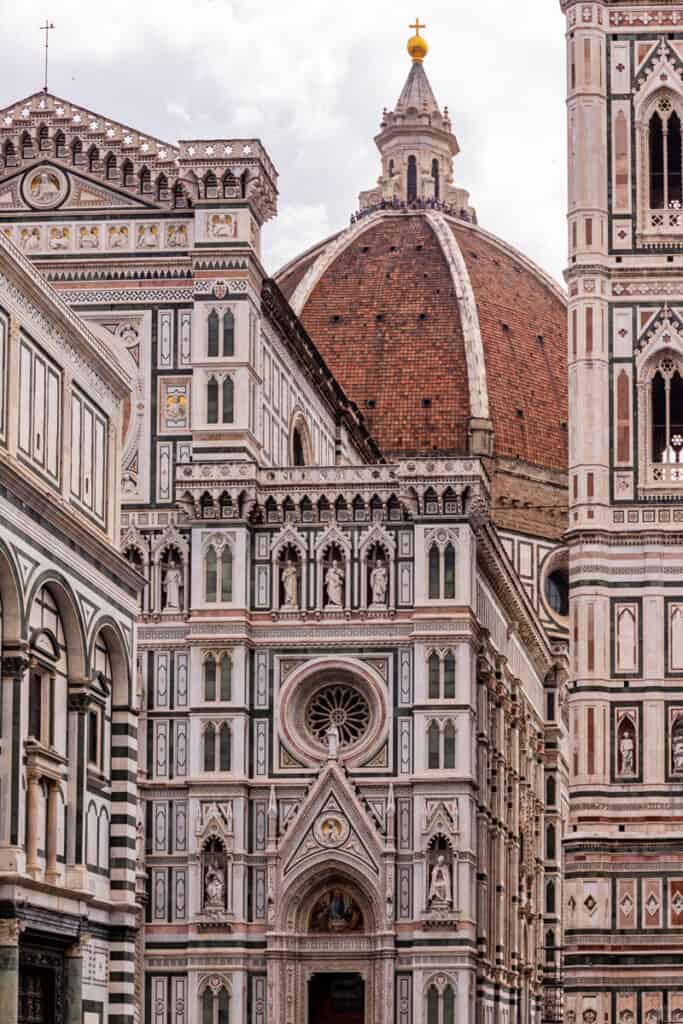
The dome was created by Brunelleschi, a sculptor and architect whose innovative plan was self-supporting, requiring no scaffolding.
One fascinating story Neb told us about the cathedral was the surprise attack orchestrated by the pope to kill all the members of the Medici family as they attended service.
A professional killer refused to take on the job, so they hired two priests!! The mobster style attack ended up with 70 people dead and one of the Medici brothers stabbed 19 times.
If found this story way more interesting than the inside of the Duomo, which is decorated like every other church in Florence with frescoes and statues.
I was surprised at how bland it was after seeing the magnificent inside of the Siena Duomo.
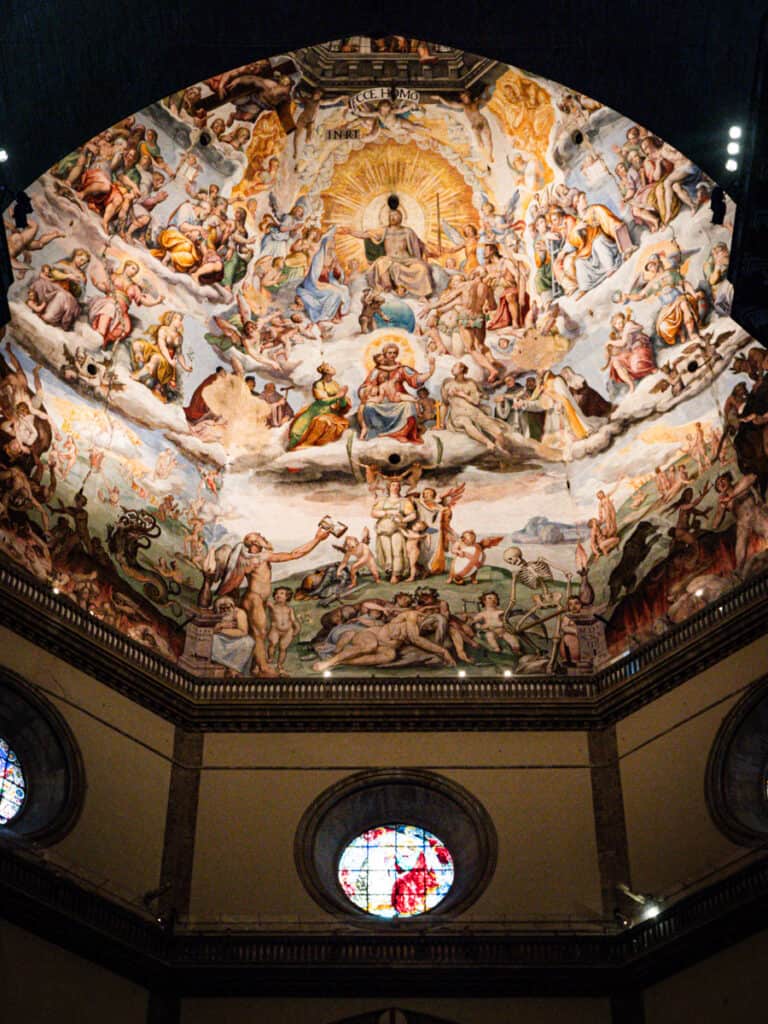
It is great to see the underside of Brunelleschi’s dome, but hard for us to get a close look with the crowds. I think the inside of the dome in St Mark’s Basilica in Venice is more impressive, albeit smaller.
However, the Florence Duomo wins for most beautiful outside façade of a church.
The architecture is absolutely striking, and like David, will leave you quite mesmerized as you wander around its green, white, and pink striped Tuscan marble façade and gigantic dome.
We wanted to climb the dome, but that tour had been all sold out (don’t leave it too late to book your tours and attractions!) but you must leave something to return to Florence for! Here is the guided tour that includes a dome climb.
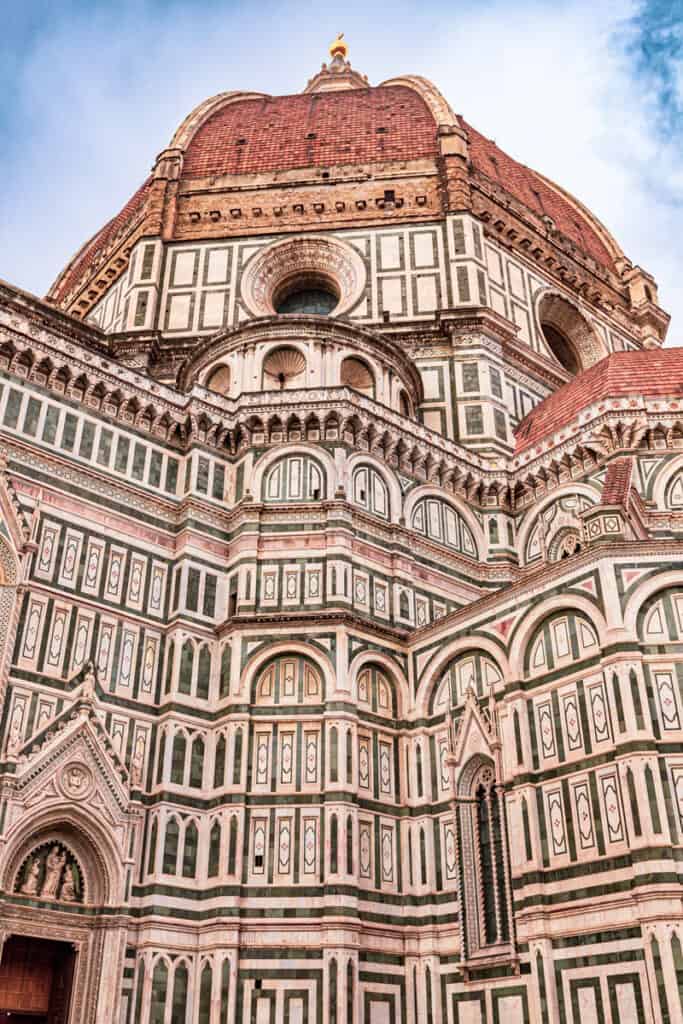
Outside the Duomo you will see Giotto’s Bell Tower, where you can climb up to see views of the Brunelleschi’s Dome.
We also swung by the Baptistery outside to ogle at some (replica) golden doors that Michelangelo gave a seriously snazzy nickname – ‘Gates of Paradise’.
I learned something new; churches build baptistries for those who were unbaptized as they were not allowed to enter the church. My unbaptized babes walked into the cathedral and walked out perfectly intact.
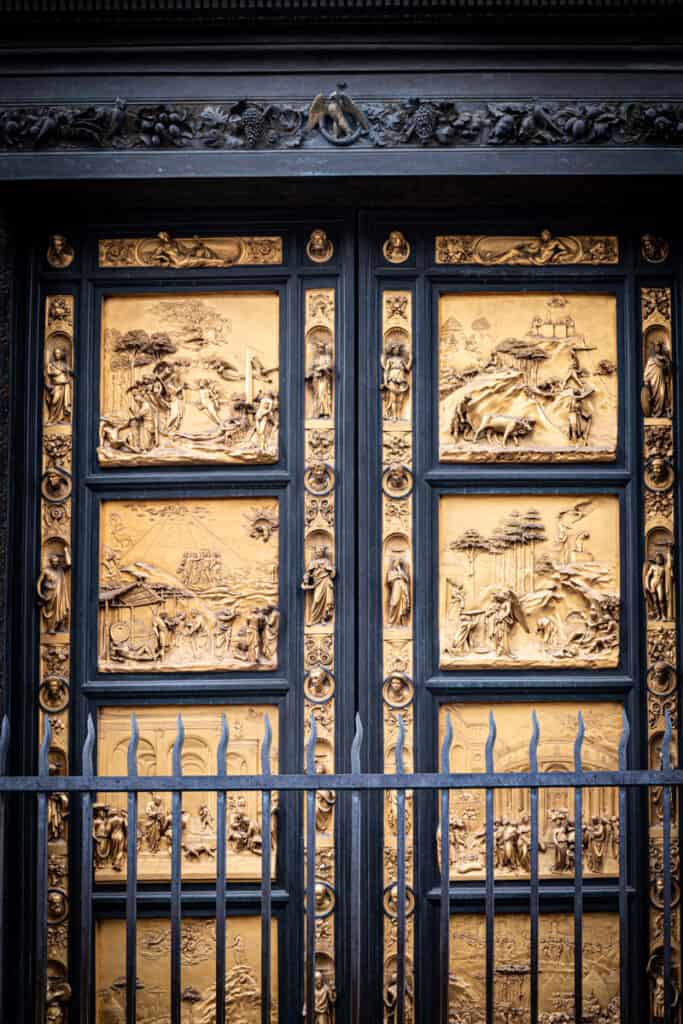
And hey, we’re skipping lines here too, ’cause ain’t nobody got time for that.
Note: you need your shoulders covered to enter the cathedral. We knew this but Kalyra and I still forgot to pack my scarves that morning. Lucky for you some very creative entrepreneurs are right at the entrance selling scarves for 5 for you. Put it down as a souvenir mistake.
They were also quickly on hand when the rain started coming down once we walked back outside.
Atypical of the weather in this part of Italy, Florence can be quite humid, which results in quick downpour here and there.
It cleared up by the end of the tour, but there were ponchos and umbrellas available for purchase if you couldn’t stand to walk around in the drizzle.
Stop 3: Walking the Streets
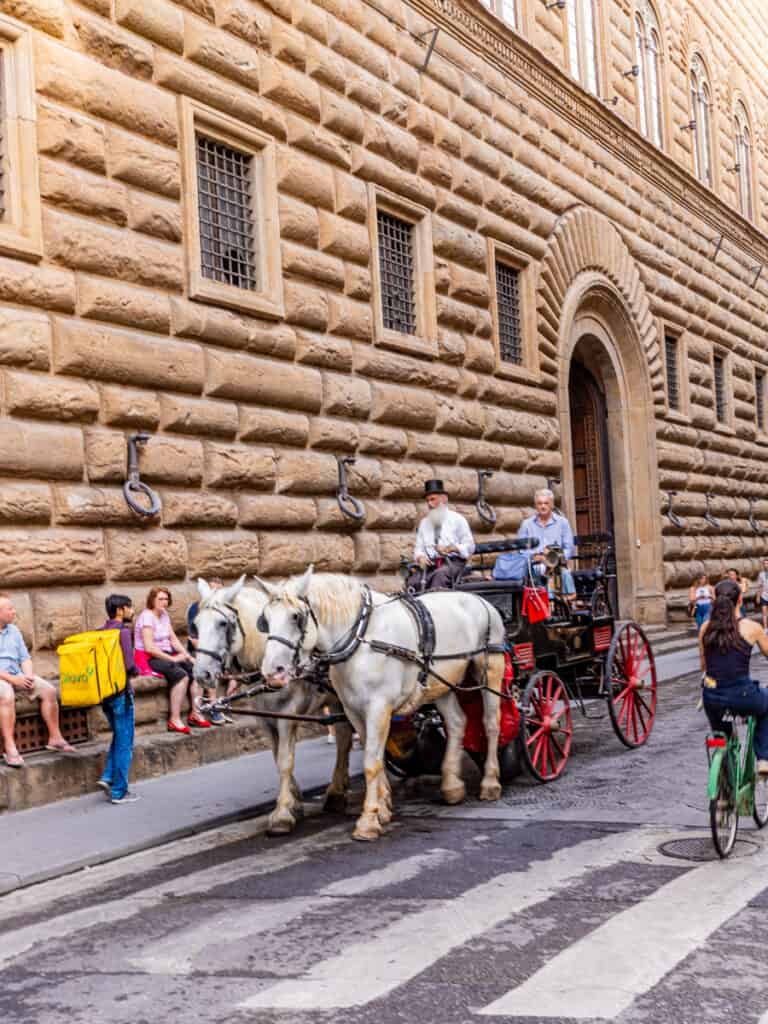
There is a lot to see as you walk the streets of Florence’s historical center. A walking tour means you won’t miss the significance of some of the things you walk by.
Neb pointed out hidden gems and important sculptures, buildings, Porcellino – the lucky wild boar at the edge of the leather market; the place where Pinocchio was written; remnants of the old Roman walls; and even a Roman road we walked down.
We learned about the Byzantine towers, stopping at one of them which is the oldest structure in the city. These towers used to stand much taller than they are now.
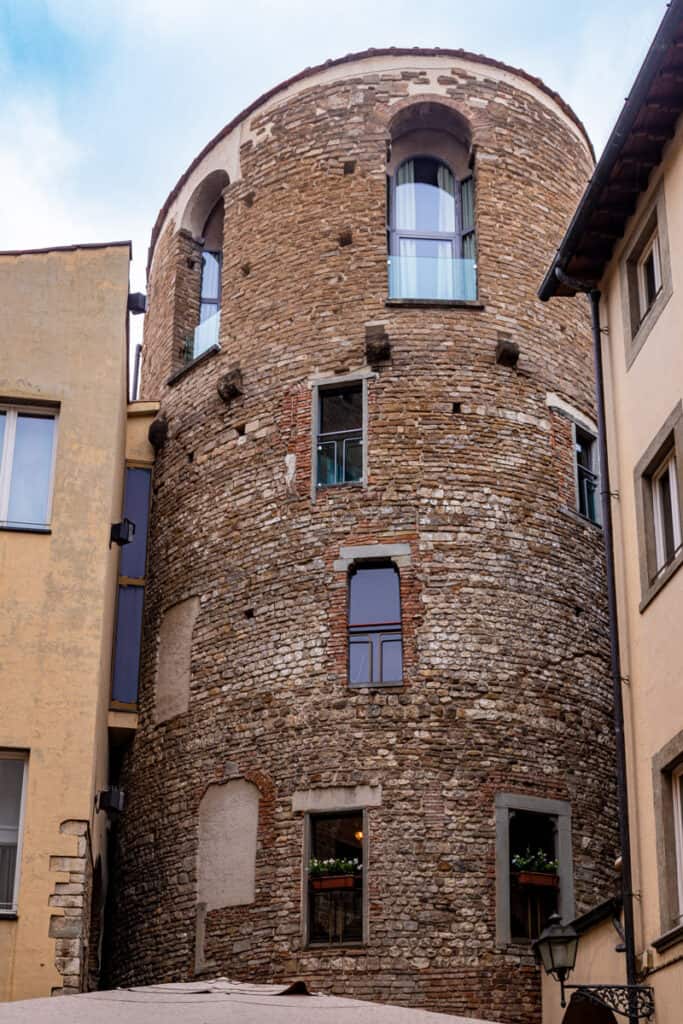
All towers in the city were chopped down to 29 meters with the first non-aristocrat government in the 1200s to limit the power of the aristocracy as these towers (more than 80) were used for defense by the aristocratic families.
You will see them randomly in the middle of Florence’s streets.
We also learned more fascinating things about Florence, one being that Florentine bankers (they made banking a thing here!) introduced many new things into the world of finance, like checks, which completely changed the movement of money into the western world.
I never learned any of this on my first visit to Florence where I wandered the streets left to my own devices!
Ned was happy to share anecdotes, legends, stories and suggestions for places to eat as we wandered through the streets. Well you know what they say – if you’re unsure of where to find the best pizza or Florentine Steak, ask the locals!
Stop 4: Piazza della Signoria’s Open-Air Gallery
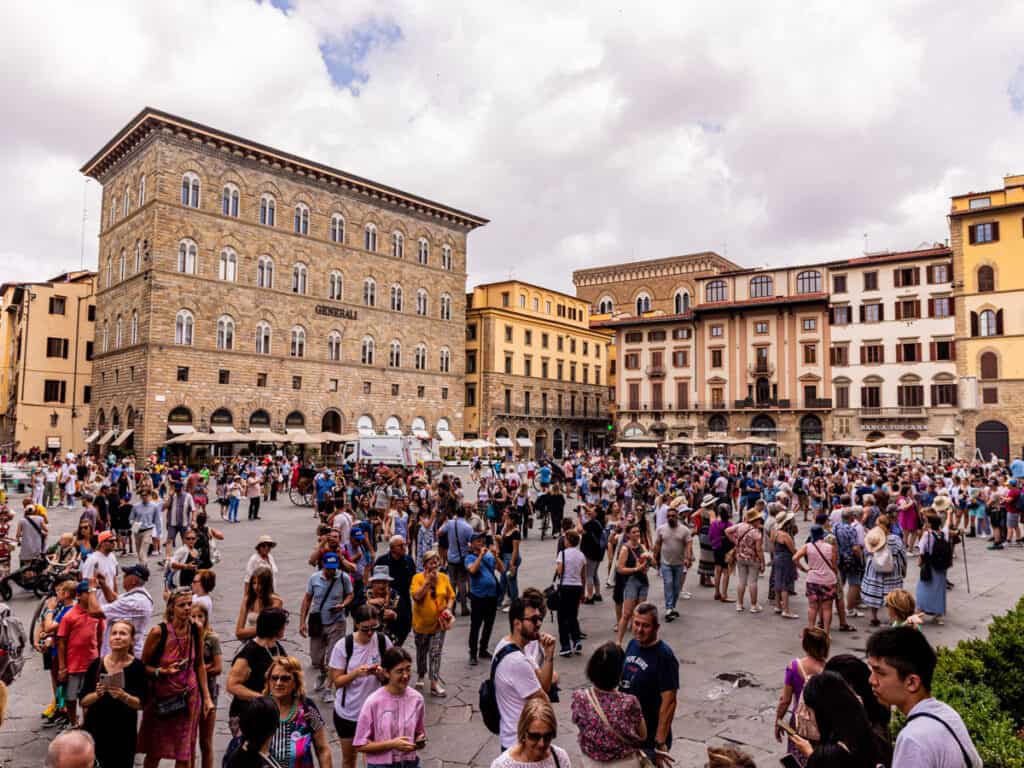
Get ready for a spin through Piazza Signoria, basically an open-air art gallery where Michelangelo’s David once stood. I think it’s the other statues in this square that will impress you, a mixture of originals and replicas.
Among the most notable sculptures gracing the square are Michelangelo’s “David,” a symbol of the city’s artistic prowess and humanism, and Benvenuto Cellini’s “Perseus with the Head of Medusa,” depicting the mythological hero holding the gorgon’s severed head. Giambologna’s “The Rape of the Sabine Women” and Bandinelli’s “Hercules and Cacus” are also prominent, contributing to the piazza’s sculptural ensemble.
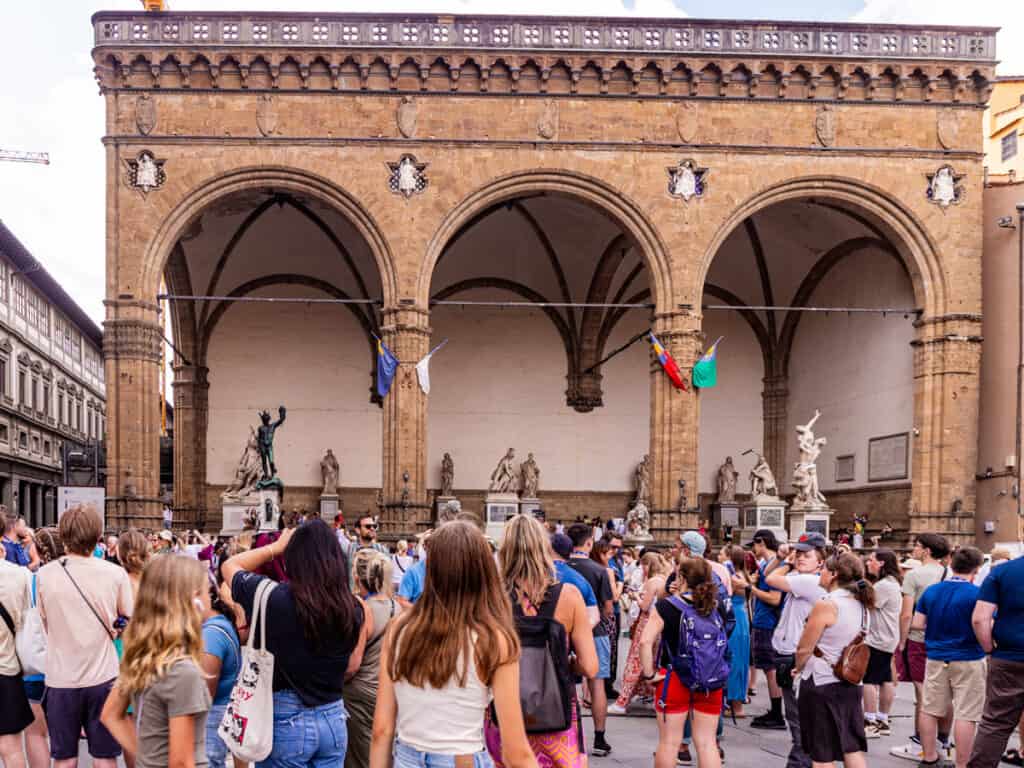
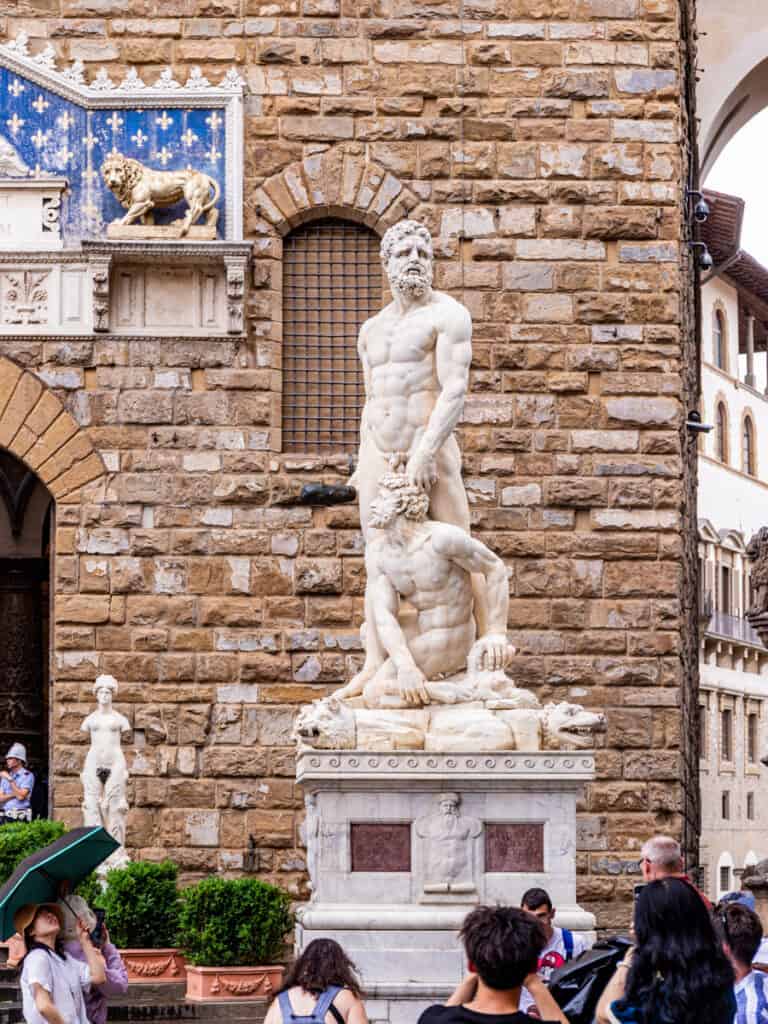
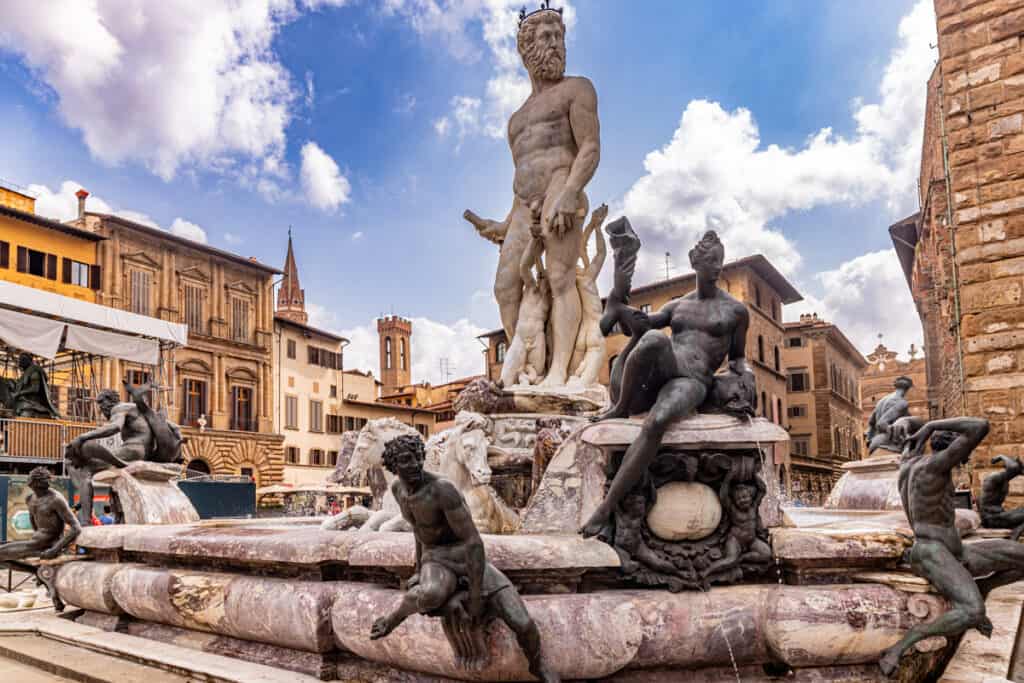
Dominating the piazza is the striking Neptune Fountain designed by sculptor Bartolomeo Ammannati in the 16th century. The fountain pays homage to Neptune, the Roman god of the sea and was commissioned by Medici after control of the coast to show their desire for naval power.
This expansive square has stood witness to centuries of history, serving as the political center of the city during the Renaissance. Its fame emanates from its role as a hub of civic life and governance, where notable events, political gatherings, and public ceremonies unfolded.
Stop 5: Palazzo Vecchio
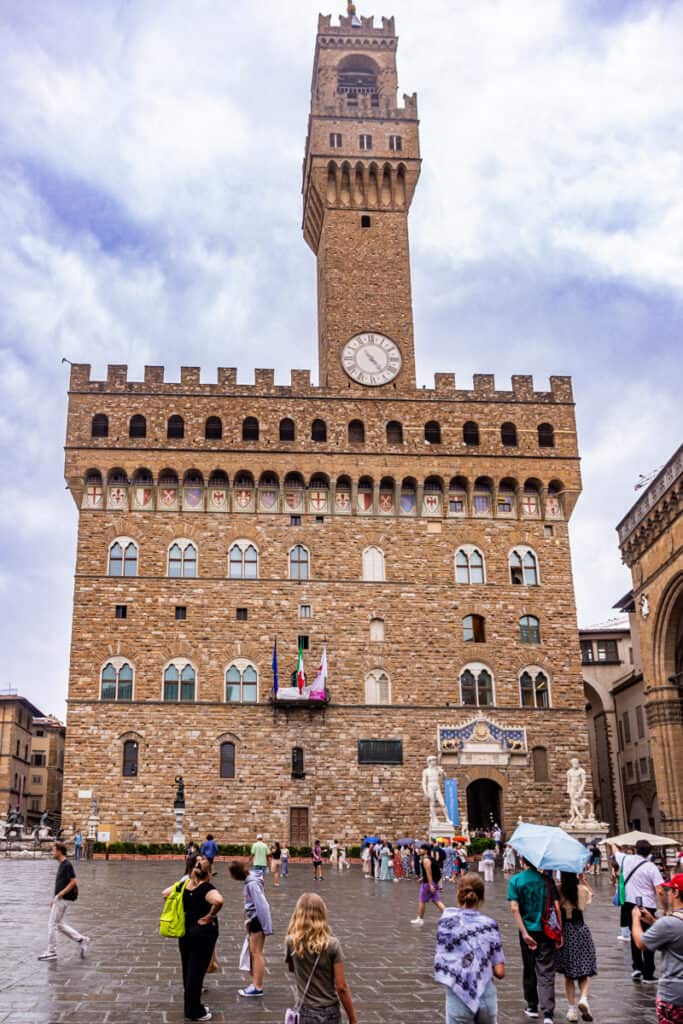
In the Square is also the fortress-like palace of Palazzo Vecchio, now a museum (but the mayor still has an office here) and is right next door to the Uffizi Gallery.
We learned more of the Medici shenanigans such, Eleonora di Toledo, wife of Cosimo I de Medici who did not like the Palace as it had no garden. With a small part of her dowry, she bought Pitti palace.
Nebu told us of the private Vasari Corridor, an elevated passageway of about 1 km long that connects Palazzo Vecchio to Palazzo Pitti on the other side of the river in Oltrarno.
It was originally built to allow the Medici Family to move between the residence safely and easily in the Pitti palace to the government offices in Palazzo Vecchio.
It’s meant to reopen in about five months to public tours.
Stop 6: A Modern Memorial for Peace
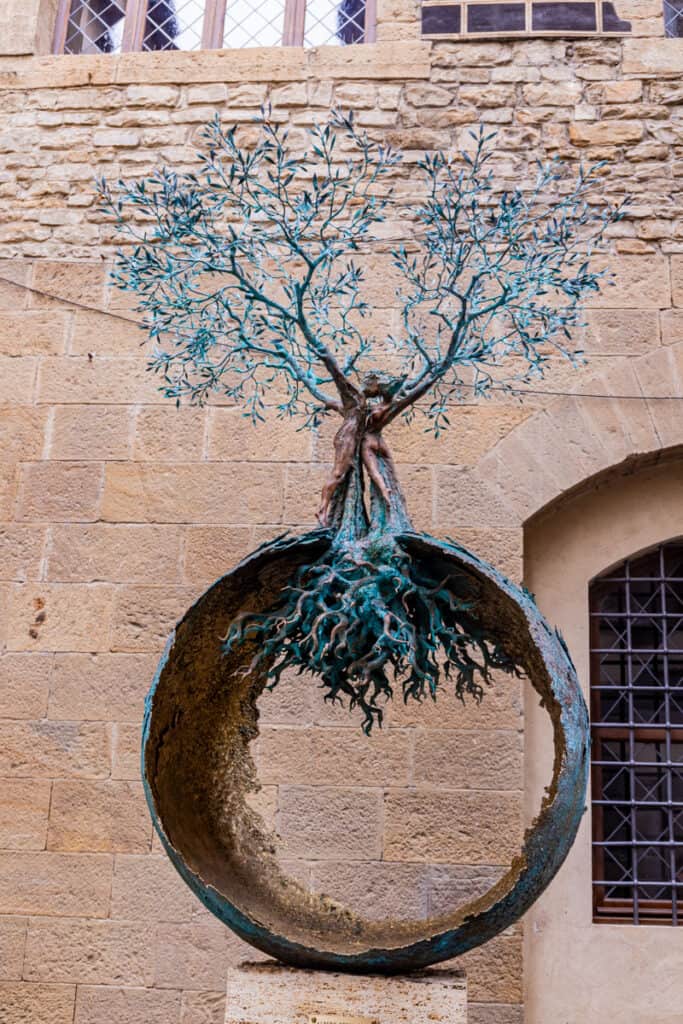
Power struggles are just a humanity issue, and so modern times aren’t void of them. We’ve all heard of the Mafia, the organized crime from Sicily. They aren’t the only ones, Calabria and Naples have one too. But, it’s the Mafia who negatively impacted modern Florentine culture.
Nebu took us to a monument of the olive tree of peace on Via dei Georgofili outside a building car bombed by the Mafia, which killed five and destroyed part of the Uffizi Gallery.
After Corleonesi Mafia clan boss Salvatore Riina was captured in January 1993, the mafia began a campaign of bombing Italian cultural heritage sites.
Florence is called the capital of arts; and according to statistics produced by UNESCO, 60% of the world’s most important works of art are in Italy and approximately half of these are in Florence. The perfect target for this hate campaign.
Stop 7: Ponte Vecchio
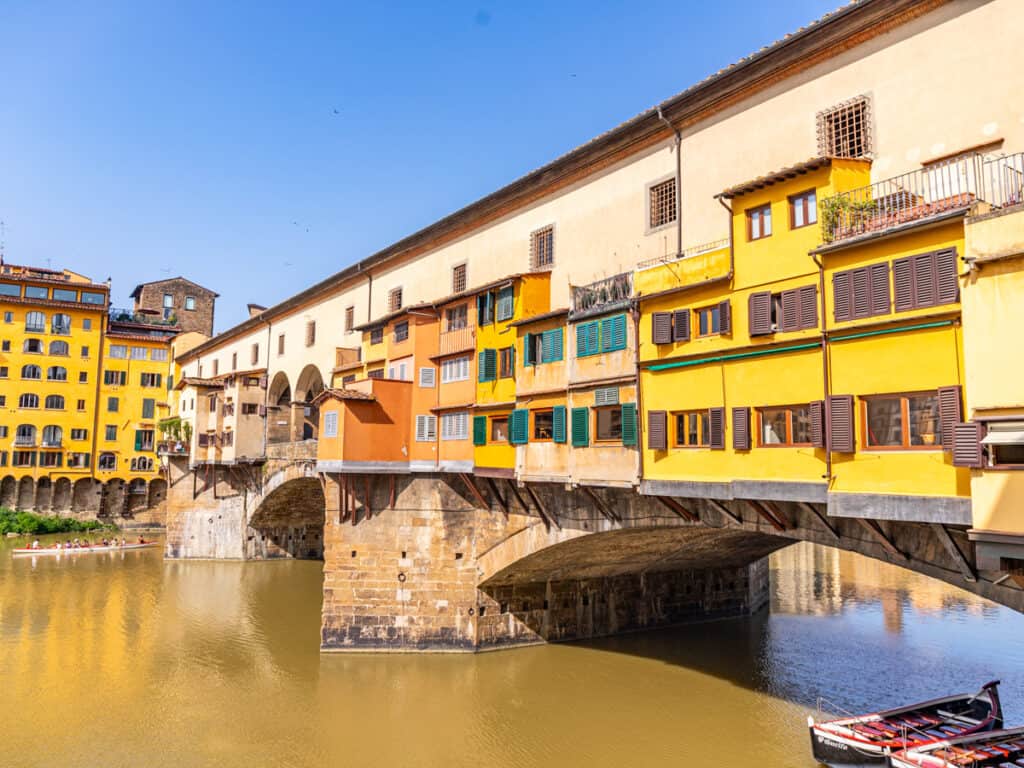
We finished our walking tour of Florence at the swoon-worthy Ponte Vecchio, an iconic old bridge built during Roman times that spans the Arno River.
What sets Ponte Vecchio apart is its unique design, consisting of three segmental arches and lined with overhanging buildings on both sides, a tradition that dates back to the medieval period.
These shops used to be occupied by butchers, but today they house a variety of merchants, including jewelers, goldsmiths, art dealers, and souvenir vendors.
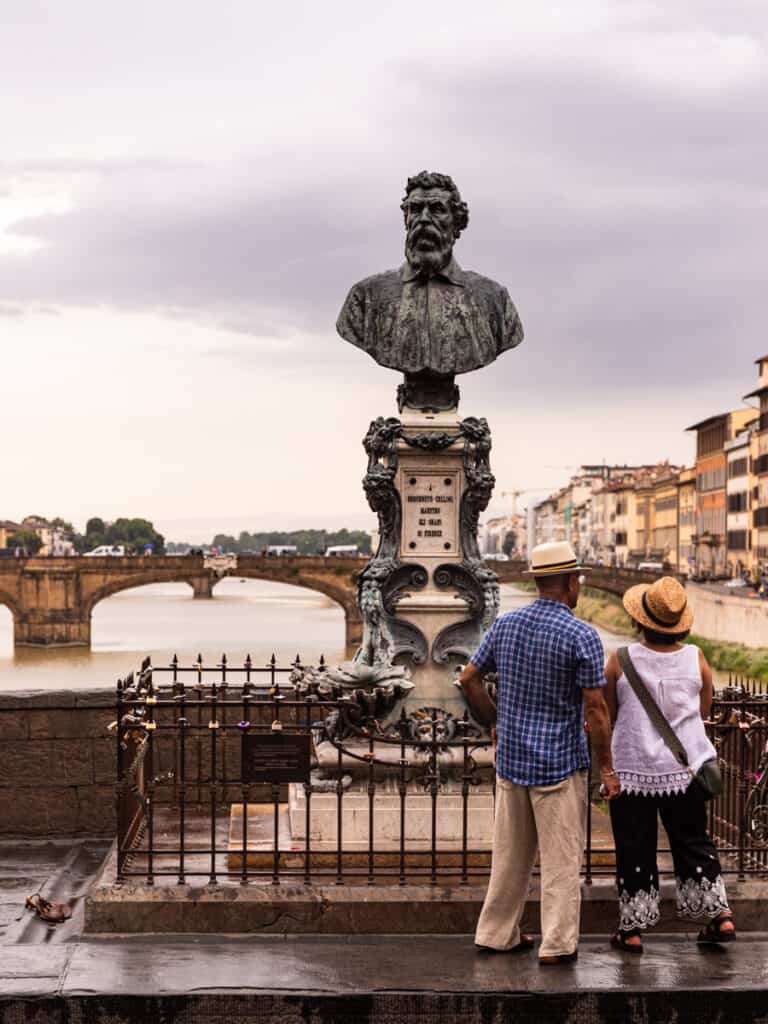
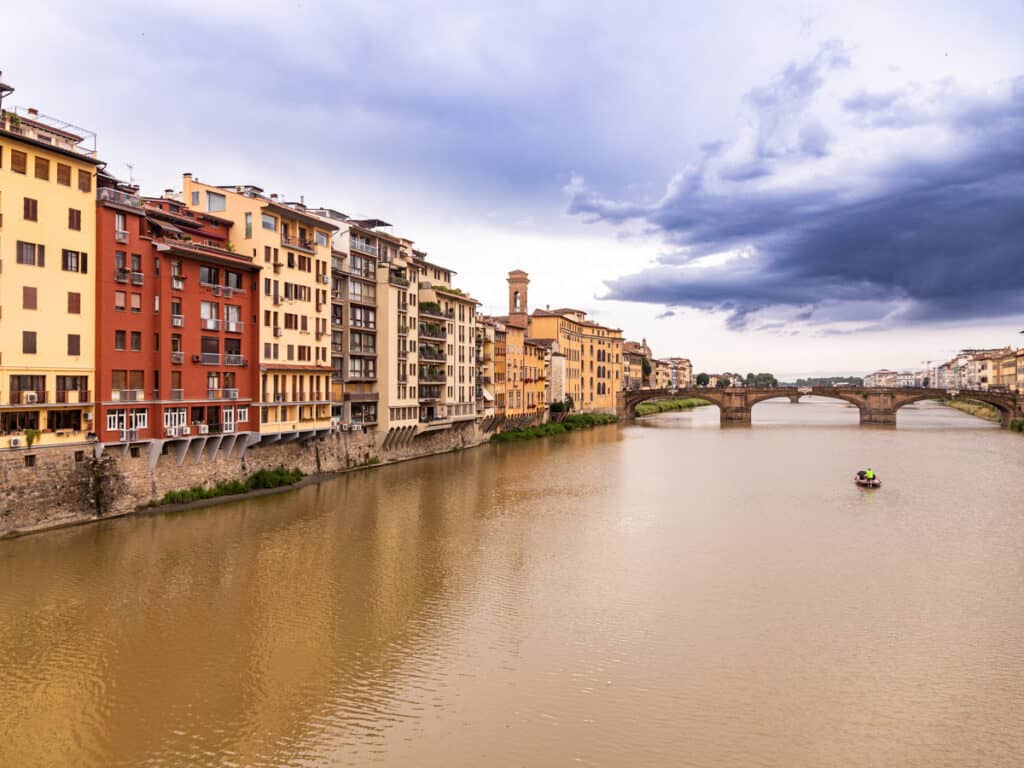
One of the significant historical events associated with Ponte Vecchio is that it was one of the few bridges in Florence to survive World War II relatively unscathed, as the retreating German army spared it from destruction because of its beauty.
This adds to the bridge’s cultural and historical significance.
The bridge not only serves as a functional crossing point but also offers breathtaking views of the Arno River and the city’s skyline. It is extremely popular during sunset!
Stop 8: A Lasting Legacy
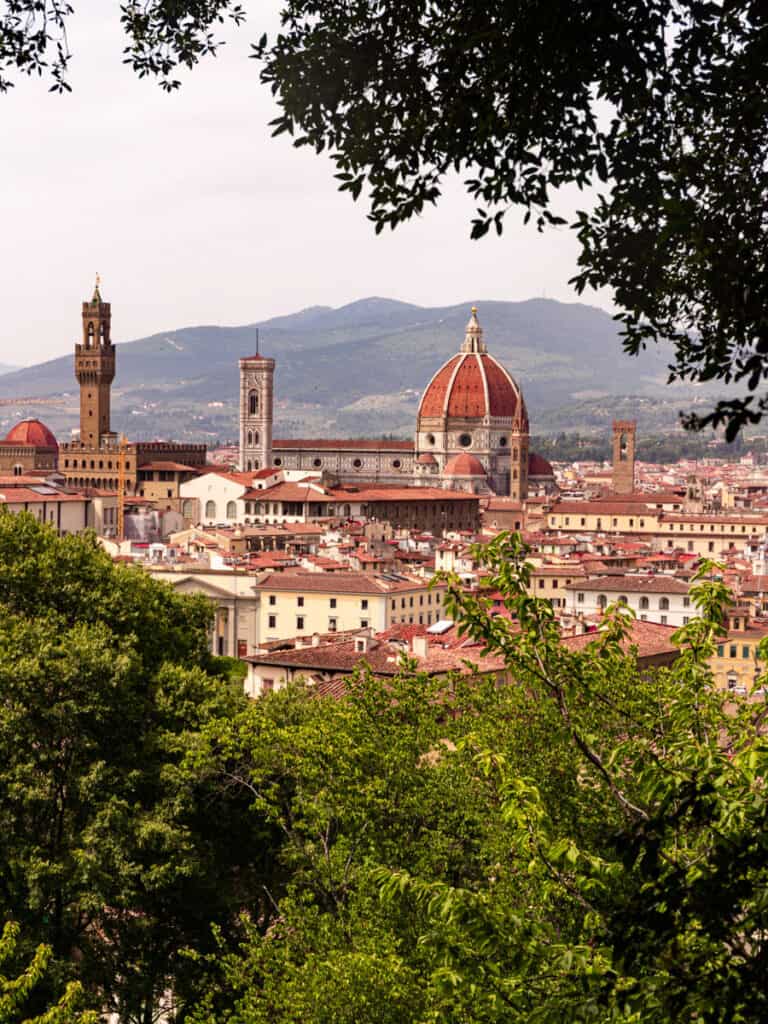
It was here our tour ended with quite a positive and heartwarming tale about the Medici Family and the legacy they left behind for the flourishing Florentine city today.
The last member of the Medici family was Anna Maria when her brother died without heirs, which meant the Grand Duchy of Tuscany would pass into the hands of Hapsburg-Lorraine, becoming a small province of a great empire, the Austrian Empire (which we learned a lot about on our Danube River cruise we went on after Italy!)
Fearing that the city would lose its artistic reputation, in 1737 Anna Maria Luisa stipulated an agreement with the Hapsburg-Lorraine that if she donated all Medicis’ large art collection, including the contents of the Uffizi, Palazzo Pitti and the Medicean villa, they would have to keep it all in Florence forever. And they agreed!
She wanted to preserve for Florentine but also the world. And for that Anna Maria, we thank you!
Final Thoughts
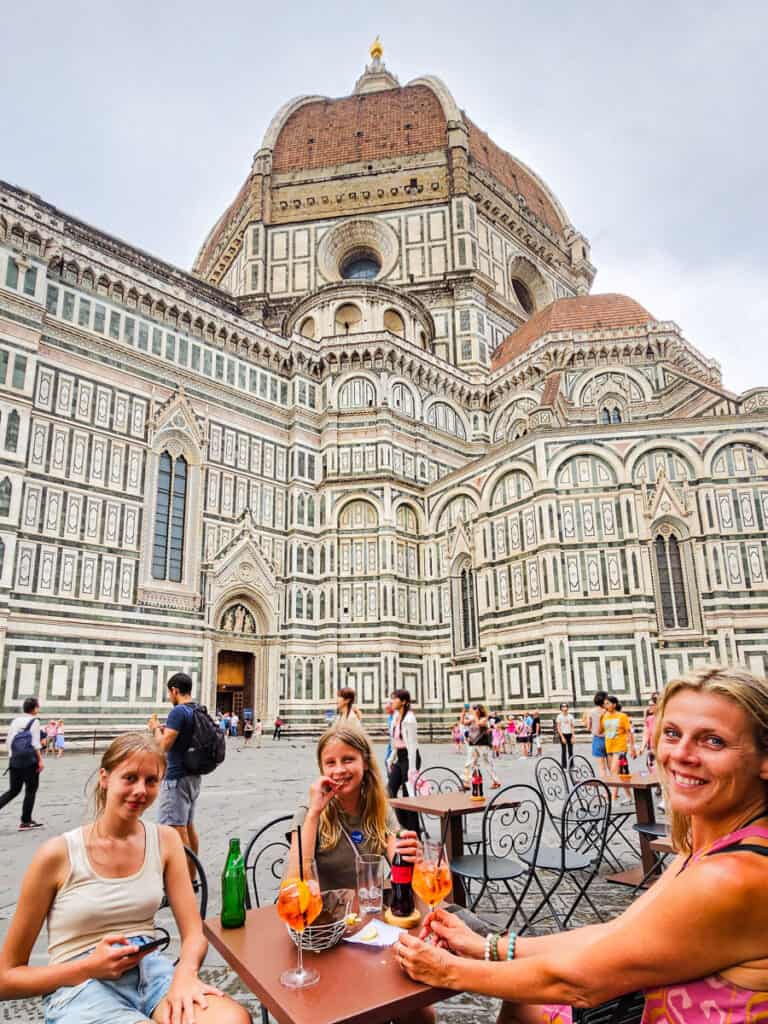
It was interesting to feel the different energy that Florence holds. There’s a dark and sinister energy here with the power play tales of the church Medici family wars, and bankers, but it’s mixed in with the renaissance rebirth of the thought leaders, scientists’ artists.
There’s no better way to feel and understand the depth of Florence’s history and culture than on a walking highlights tour.
And this tour didn’t even dive into its other transformative story for cultures across the world: it is the birthplace of gelato!
So be sure to stop in at one at the end of the tour as you discuss all you saw and learned about Florence (or head straight to a Florence food tour!)
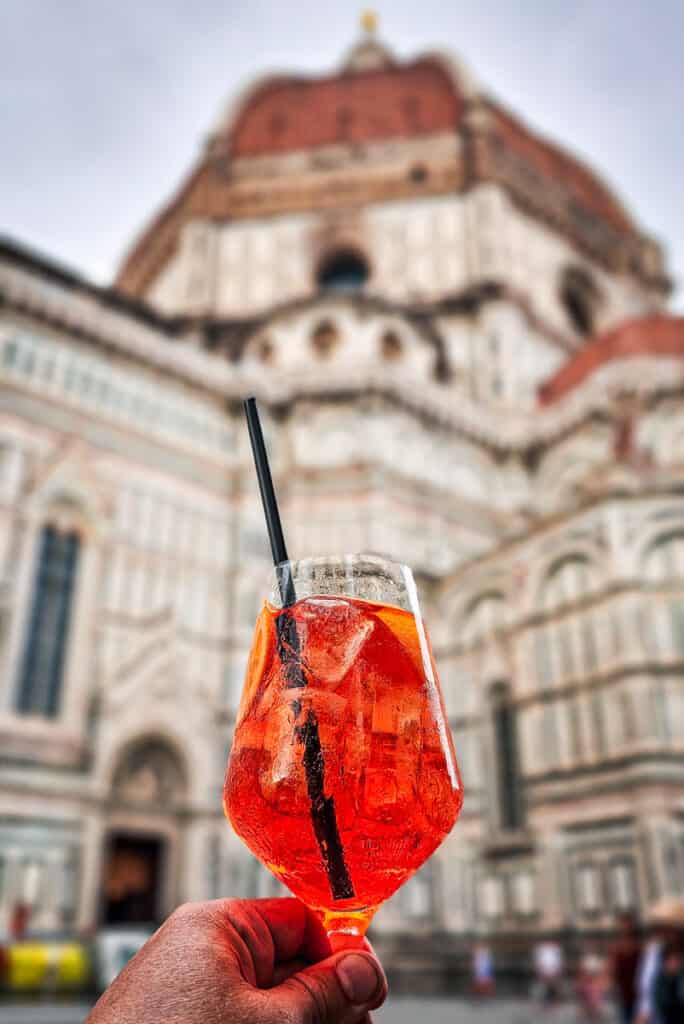
We made our way back to the Duomo so we could enjoy those views a little longer with an Aperol Spritz.
So, if you’re down for a whirlwind history plunge and a rendezvous with the masterminds who shaped the world, the Best of Florence Tour is your golden ticket. Get ready to walk, learn, and be swept off your feet by this enchanting city!